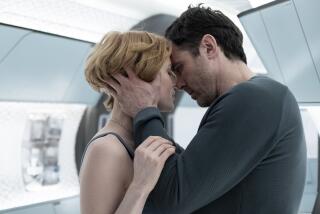Brian De Palma’s Science Project
“Nobody ever wanted Mars the way you two did.”
“The control module doesn’t have enough thrust.”
“Come on, people, work the problem.”
“Is that what I think it is?”
“Luke needs us now.”
“He would have wanted you to have this.”
“I didn’t come 100 million miles to turn back in the last 10 feet.”
Had enough yet? If you haven’t, there’s a whole lot more clunky, unconvincing and just plain bad dialogue left to sample in “Mission to Mars,” a movie as cold and distant as the Red Planet itself.
A notably lifeless film about the possibilities of life on Mars, “Mission” was written by Jim Thomas & John Thomas and Graham Yost from a story by Lowell Cannon and the Thomases. Between them these writers--and it’s rumored that there were more--have credits on films such as “Predator,” “Broken Arrow,” “Hard Rain” and “Wild Wild West,” so maybe the pained looks on actors Gary Sinise, Tim Robbins and Don Cheadle shouldn’t come as any surprise.
Not listening very hard to these inept conversations was director Brian De Palma. Known for his virtuoso visual style, De Palma was understandably enthralled by the many technical challenges a story set almost exclusively in space vehicles and on the surface of another planet presented. As a result, “Mission to Mars” is often beautifully composed and worth looking at even when you’re wishing there was some way you could turn off the sound.
Set in the near future of the year 2020, “Mission to Mars” begins, typically, with some of De Palma’s trademark roving camera work servicing the dramatic dead zone, in this case a backyard barbecue and goodbye party for a team of astronauts headed for Mars.
Here’s Mission Cmdr. Luke Graham (Cheadle), a caring scientist. Here’s Woody Blake (Robbins), as much of a square-shooter as his “Toy Story” namesake, whose wife, Terri Fisher (Connie Nielsen), is an astronaut as well. And here’s comic-relief colleague Phil Ohlmyer (Jerry O’Connell), trying without success to get unattached women to make his last night on Earth a memorable one.
The only person not here, in fact, is hotshot cover-of-Time-magazine pilot Jim McConnell (Sinise, looking, in his leather jacket and sports car, like the junior varsity version of Sam Shepard). Jim finally shows, but it’s with a tear in his heart. And who could blame the guy: After training with his wife for 12 years to be the first couple on Mars, she was stricken with cancer and Jim could do no more than watch while the poor woman “wasted away in front of his eyes.”
Luke goes to Mars with Jim’s blessing, but then, wouldn’t you know it, something sinister and inexplicable happens up there. Investigating a mysterious formation on the planet’s surface, Luke and his team fall afoul of a fierce and unfriendly energy force that allows no more than a garbled message for help to reach the World Space Station.
Garbled or not, the message energizes Luke’s pals Woody, Phil and Terri, who are determined to mount a rescue mission, no matter what the risk. And they insist on having grieving Jim, the space jockey’s space jockey, sitting in the co-pilot’s seat.
Of course, a whole variety of troublesome situations bedevil this intrepid crew once it’s airborne. Even though the events surprise Woody, Phil, Terri and Jim, they will be more than familiar to anyone who’s experienced even a bit of science fiction. All the film’s plotting has a pro forma feeling to it and, without the kind of pizazz the “Star Trek” movie series manages to bring to similar material, the effect is deadly.
De Palma, working with his longtime cinematographer and editor (Stephen H. Burum and Paul Hirsch, respectively) and a veteran production designer (Ed Verreaux) who is new to his team, likely spent most of his energy trying to create luminous images out of “Mission to Mars’ ” numerous logistical challenges.
The film’s press material, much more intriguing than what’s on the screen, lets you know what was involved. Interior shots were done in a facility so large that parts of the Golden Gate Bridge were once constructed there, and 55 acres of the Fraser Sand Dunes outside of Vancouver were transformed into Mars with the use of thousands of square yards of “shotcrete, a sprayable form of concrete” and then spray-painted with “100 gallons of environmentally friendly Mars Red latex paint per minute. A total of 120,000 gallons of paint were used on the Martian surface.”
The most striking images are those within the space vehicles themselves. One visual inside the recovery ship’s living quarters used a 3 1/2-story spinning wheel to simulate the spaceship’s continual turning while the astronauts go about their daily business. It’s a wonderful piece of filmmaking, but once any mouth is opened the magic is immediately tarnished. “Critical systems alert,” one of the on-board computers announces at one point, and it’s hard not to respond with a heartfelt “No kidding.”
*
MPAA rating: PG for sci-fi violence and mild language. Times guidelines: One astronaut gets torn apart and another commits suicide.
‘Mission to Mars’
Tim Robbins: Woody Blake
Gary Sinise: Jim McConnell
Don Cheadl:: Luke Graham
Connie Nielsen: Terri Fisher
Touchstone Pictures presents a Jacobson Co. production, released by Buena Vista Pictures. Director Brian De Palma. Producer Tom Jacobson. Executive producer Sam Mercer. Screenplay Jim Thomas & John Thomas and Graham Yost. Story by Lowell Cannon and Jim Thomas & John Thomas. Cinematographer Stephen H. Burum. Editor Paul Hirsch. Production designer Ed Verreaux. Music Ennio Morricone. Costumes Sanja Milkovic Hays. Art directors Thomas Valentine, Andrew Neskoromny. Set decorator Lin Macdonald. Running time: 1 hour, 53 minutes.
In general release.
More to Read
Only good movies
Get the Indie Focus newsletter, Mark Olsen's weekly guide to the world of cinema.
You may occasionally receive promotional content from the Los Angeles Times.











